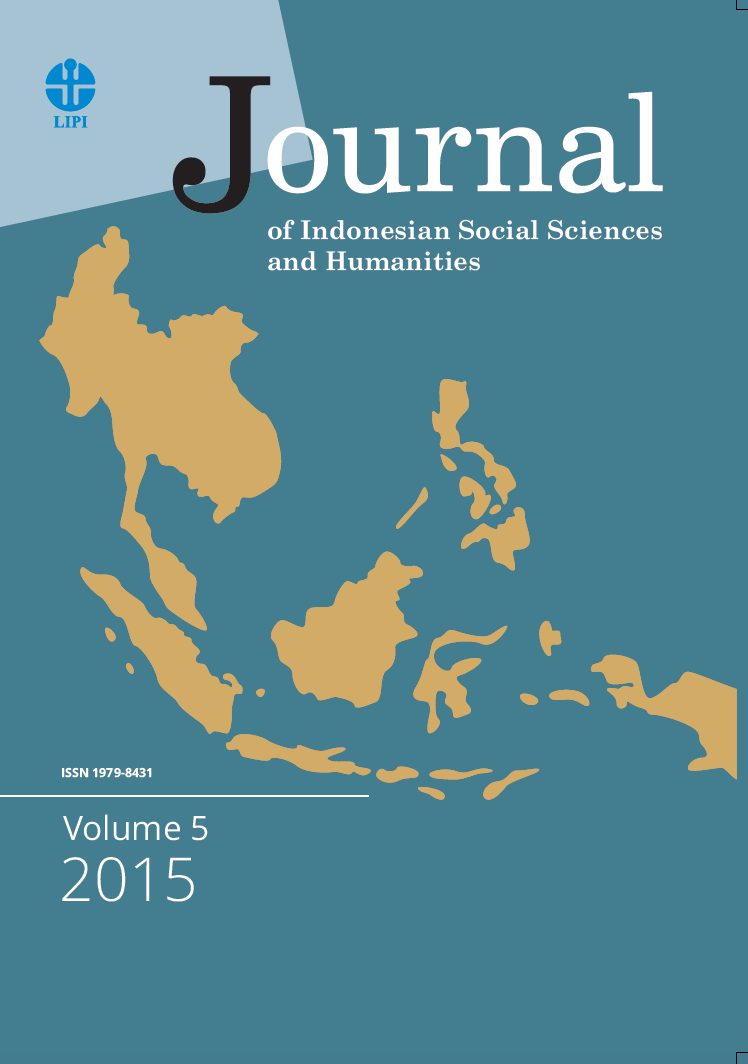Regional Shift to Bahasa Indonesia: ‘Old Vernacular’ In A New Identity
Keywords:
Gamkonora, Indonesia, Language shiftAbstract
The Gamkonora people are an ethnic group in Indonesia whose members have an outstanding linguistic ability: they are able to speak more than two languages, that is, two or more of Gamkonora, Ternatan-Malay, Ternate, and Bahasa Indonesia. The use of these languages is related to the residual traces of the powers that have ruled the area in the history of North Maluku: the Ternate sultanate, European colonialists and Indo nesian central government since independence. Reflecting on the current language behaviour of the Gamko noran younger generation, which tends to be the Indonesian language (read Malay); the authors question how far the Gamkonoran’s Indonesian language ability has influenced their Gamkonoran language and culture. Through ethnographic studies, the authors found that two languages—Indonesian and Gamkonoran—have different roles in their culture. Therefore, the language shift to Bahasa Indonesia by Gamkonoran youth will not replace the Gamkonoran language because the use of their tribal language is supported by their traditional institutions.
References
Amal, M Adnan. (2009). Kepulauan rempah-rempah: perjalanan sejarah Maluku Utara–1950, 2nd edn. Makasar: Pusat Kajian Agama dan Masyarakat, UIN Alauddin.
Ehala, Martin. (2010). ‘Refining the notion of ethnolinguistic vitality’. International journal of multilingualism, 7(4): 363–378. http://dx.doi.org/10.1080/14790711003637094. Accessed on May 31st, 2012
Fairclough, Norman. (1995). Critical discourse analysis: papers in the critical study of language. Harlow: Longman.
Fraassen, Ch F Van. (1980). ‘Types of socio-political structure in North-Halmahera History’. In EKM Masinambow. Halmahera dan Raja Ampat: konsep dan strategi penelitian. Jakarta: LEKNAS–LIPI.
Johnston, John. (1992). ‘Translation as simulacrum’. In Lawrence Venuti. Rethinking translation. London and New York: Routledge, pp. 52–53.
Mühlhäusler, Peter (2001). ‘Talking about environmental issues’. In Alwin Fill and Peter Mühlhäusler (eds). The ecolinguistics reader: language, ecology and environment. London and New York: Continuum.
Haugen, Einar. (2001). ‘The ecology of language’. In Alwin Fill and Peter Mühlhäusler (eds). The ecolinguistics reader: language, ecology and environment. London and New York: Continuum.
Imelda. (2011). ‘Bahasa dan kuasa: kajian ranah agama dan implikasinya’. In Ninuk Kleden-Probonegoro, Imelda and Fanny Henry Tondo. Etnografi kebahasaan dan kebudayaan: memahami eksistensi Bahasa Gamkonora. Jakarta: LIPI Press.
Lewis, M Paul, Gary F Simons and Charles D Fennig (eds). (2013). Ethnologue: languages of the world, 17th edn. Dallas: SIL International. Online version: http://www.ethnologue.com.
O’Shannessy, Carmel. (2011). ‘Language contact and change in endangered languages’. In Peter K Austin and Julia Sallabank (eds.). The Cambridge handbook of endangered languages. Cambridge: Cambridge University Press
Downloads
Published
Issue
Section
License
Copyright (c) 2015 Ninuk Kleden-Probonegoro, Imelda

This work is licensed under a Creative Commons Attribution-ShareAlike 4.0 International License.
Authors who publish with this journal agree to the following terms:
1. Authors retain copyright and grant the journal right of first publication with the work simultaneously licensed under an Attribution-ShareAlike 4.0 International (CC BY-SA 4.0) license. This license allows others to remix, adapt, and build upon the work, as long as they credit the author and license their new creations under the same terms.
2. Authors may enter into separate, additional contractual arrangements for the non-exclusive distribution of the journal’s published version of the work (e.g., posting it to an institutional repository or including it in a book), provided there is an acknowledgment of its initial publication in this journal.
3. Authors are permitted and encouraged to post their work online (e.g., in institutional repositories or on their personal website) prior to and during the submission process, as this can lead to productive exchanges and increase citations of the published work (See The Effect of Open Access ).


















